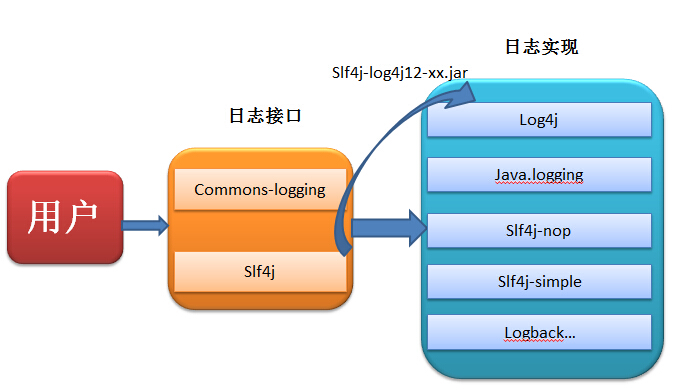жӮЁеҘҪпјҢзҷ»еҪ•еҗҺжүҚиғҪдёӢи®ўеҚ•е“ҰпјҒ
жӮЁеҘҪпјҢзҷ»еҪ•еҗҺжүҚиғҪдёӢи®ўеҚ•е“ҰпјҒ
жң¬зҜҮеҶ…е®№д»Ӣз»ҚдәҶвҖңwebж—Ҙеҝ—жәҗз ҒеҲҶжһҗвҖқзҡ„жңүе…ізҹҘиҜҶпјҢеңЁе®һйҷ…жЎҲдҫӢзҡ„ж“ҚдҪңиҝҮзЁӢдёӯпјҢдёҚе°‘дәәйғҪдјҡйҒҮеҲ°иҝҷж ·зҡ„еӣ°еўғпјҢжҺҘдёӢжқҘе°ұи®©е°Ҹзј–еёҰйўҶеӨ§е®¶еӯҰд№ дёҖдёӢеҰӮдҪ•еӨ„зҗҶиҝҷдәӣжғ…еҶөеҗ§пјҒеёҢжңӣеӨ§е®¶д»”з»Ҷйҳ…иҜ»пјҢиғҪеӨҹеӯҰжңүжүҖжҲҗпјҒ

йҖҡиҝҮжң¬еӣҫеҸҜд»ҘзҗҶжё…жҘҡж—Ҙеҝ—д№Ӣй—ҙзҡ„е…ізі»пјҢ
commons-loggingе’Ңslf4jйғҪжҳҜж—Ҙеҝ—зҡ„жҺҘеҸЈпјҢдҫӣз”ЁжҲ·дҪҝз”ЁпјҢиҖҢжІЎжңүжҸҗдҫӣе®һзҺ°пјҒ
log4j,logbackзӯүзӯүжүҚжҳҜж—Ҙеҝ—зҡ„зңҹжӯЈе®һзҺ°гҖӮ
зӣ®еүҚзҡ„ж—Ҙеҝ—жЎҶжһ¶жңүjdkиҮӘеёҰзҡ„loggingпјҢlog4j1гҖҒlog4j2гҖҒlogback
зӣ®еүҚз”ЁдәҺе®һзҺ°ж—Ҙеҝ—з»ҹдёҖзҡ„жЎҶжһ¶apacheзҡ„commons-loggingгҖҒslf4j
дёәдәҶзҗҶжё…е®ғ们зҡ„е…ізі»пјҢдёҺз№ҒжқӮзҡ„еҗ„з§ҚйӣҶжҲҗjarеҢ…пјҢеҰӮдёӢпјҡ
log4jгҖҒlog4j-apiгҖҒlog4j-core
log4j-1.2-apiгҖҒlog4j-jclгҖҒlog4j-slf4j-implгҖҒlog4j-jul
logback-coreгҖҒlogback-classicгҖҒlogback-access
commons-logging
slf4j-apiгҖҒslf4j-log4j12гҖҒslf4j-simpleгҖҒjcl-over-slf4jгҖҒslf4j-jdk14гҖҒlog4j-over-slf4jгҖҒslf4j-jcl
1.jdk иҮӘеёҰзҡ„logпјҢ
java.util.logging.Logger l = java.util.logging.Logger.getLogger(Deme.class.getName());
жҹҘзңӢжәҗз ҒпјҢдё»иҰҒжҳҜжһ„е»әLoggerManageзҡ„ж—¶еҖҷиҜ»еҸ–й…ҚзҪ®ж–Ү件
public static LogManager getLogManager() {
if (manager != null) {
manager.ensureLogManagerInitialized();
}
return manager;
}
final void ensureLogManagerInitialized() {
final LogManager owner = this;
//зңҒз•Ҙ
// Read configuration.
owner.readPrimordialConfiguration();
}
private void readPrimordialConfiguration() {
//зңҒз•Ҙ
readConfiguration();
}
public void readConfiguration() throws IOException, SecurityException {
//зңҒз•Ҙ
//й»ҳи®ӨжҳҜjreзӣ®еҪ•дёӢзҡ„lib/logging.propertiesж–Ү件пјҢд№ҹеҸҜд»ҘиҮӘе®ҡд№үдҝ®ж”№зі»з»ҹеұһжҖ§"java.util.logging.config.file",жәҗз ҒеҰӮдёӢпјҡ
String fname = System.getProperty("java.util.logging.config.file");
if (fname == null) {
fname = System.getProperty("java.home");
if (fname == null) {
throw new Error("Can't find java.home ??");
}
File f = new File(fname, "lib");
f = new File(f, "logging.properties");
fname = f.getCanonicalPath();
}
try (final InputStream in = new FileInputStream(fname)) {
final BufferedInputStream bin = new BufferedInputStream(in);
readConfiguration(bin);
}
}2.1 log4j1 зңҹжӯЈе®һзҺ°ж—Ҙеҝ—иҜ»еҶҷ
//jarеҢ…еј•е…Ҙ
<dependency>
<groupId>log4j</groupId>
<artifactId>log4j</artifactId>
<version>1.2.17</version>
</dependency>
//еҲқе§ӢеҢ–пјҢжҹҘзңӢжәҗз Ғ,
org.apache.log4j.Logger logger1 = org.apache.log4j.Logger.getLogger("class or className");public class Logger extends Category {
//еҸҜд»ҘзңӢеҲ° Logger继жүҝдәҶCategory зұ»пјҢиҝҷдёӘзұ»жү“еҚ°ж—Ҙеҝ—дҝЎжҒҜзҡ„ж—¶еҖҷжңүз”ЁгҖӮ
Logger getLogger(String name) {
return LogManager.getLogger(name);
}
}
public class LogManager {
//дё»иҰҒжҳҜ LogManager зҡ„getLoggerж–№жі•
Logger getLogger(final String name) {
// Delegate the actual manufacturing of the logger to the logger repository.
return getLoggerRepository().getLogger(name);
}
//LogManager зұ»жңүдёӘйқҷжҖҒж–№жі•
static {
//еҲқе§ӢеҢ–дёҖдёӘloggerд»“еә“HierarchyпјҢ然еҗҺз»‘е®ҡеҲ°LoggerManagerдёҠпјҢдё»иҰҒжҳҜйҖҡиҝҮgetLoggerRepository()ж–№жі•иҺ·еҸ–гҖӮ
// By default we use a DefaultRepositorySelector which always returns 'h'.
Hierarchy h = new Hierarchy(new RootLogger((Level) Level.DEBUG));
repositorySelector = new DefaultRepositorySelector(h);
/** Search for the properties file log4j.properties in the CLASSPATH. */
String override =OptionConverter.getSystemProperty(DEFAULT_INIT_OVERRIDE_KEY,
null);
// if there is no default init override, then get the resource
// specified by the user or the default config file.
if(override == null || "false".equalsIgnoreCase(override)) {
String configurationOptionStr = OptionConverter.getSystemProperty(DEFAULT_CONFIGURATION_KEY ,null);
//зңҒз•Ҙд»Јз Ғ
// иҝҷйҮҢй…ҚзҪ®ж–Ү件жңүдёӘеҠ иҪҪйЎәеәҸ
// log4j.defaultInitOverride > log4j.configuration > log4j.xml > log4j.properties
}
//йҖҡиҝҮжҹҘзңӢHierarchyиҝҷдёӘзұ»
}
public class Hierarchy implements LoggerRepository, RendererSupport, ThrowableRendererSupport {
private LoggerFactory defaultFactory; //еҲӣе»әLoggerе·ҘеҺӮ
Hashtable ht; //еӯҳж”ҫе·ҘеҺӮеҲӣе»әзҡ„Logger
Logger root; //з”ЁдәҺжүҝиҪҪи§Јжһҗй…ҚзҪ®ж–Ү件зҡ„з»“жһңпјҢи®ҫзҪ®зә§еҲ«пјҢеҗҢж—¶еӯҳж”ҫappender
//зңҒз•Ҙ
//жһ„йҖ ж–№жі•
public Hierarchy(Logger root) {
ht = new Hashtable();
listeners = new Vector(1);
this.root = root;
// Enable all level levels by default.
setThreshold(Level.ALL);
this.root.setHierarchy(this);
rendererMap = new RendererMap();
defaultFactory = new DefaultCategoryFactory();
}
}2.2 log4j2 ж—Ҙеҝ—жәҗз Ғи§Јжһҗ
//ж·»еҠ jarеҢ…пјҢ <dependency> <groupId>org.apache.logging.log4j</groupId> <artifactId>log4j-api</artifactId> <version>2.2</version> </dependency> <dependency> <groupId>org.apache.logging.log4j</groupId> <artifactId>log4j-core</artifactId> <version>2.2</version> </dependency> og4j2еҲҶжҲҗ2дёӘйғЁеҲҶпјҡ log4j-apiпјҡ дҪңдёәж—Ҙеҝ—жҺҘеҸЈеұӮпјҢз”ЁдәҺз»ҹдёҖеә•еұӮж—Ҙеҝ—зі»з»ҹ log4j-core : дҪңдёәдёҠиҝ°ж—Ҙеҝ—жҺҘеҸЈзҡ„е®һзҺ°пјҢжҳҜдёҖдёӘе®һйҷ…зҡ„ж—Ҙеҝ—жЎҶжһ¶ web.xml ж·»еҠ еҰӮдёӢдҝЎжҒҜ <listener> <listener-class>org.apache.logging.log4j.web.Log4jServletFilter</listener-class> </listener> <filter> <filter-name>log4jServletFilter</filter-name> <filter-class>org.apache.logging.log4j.web.Log4jServletFilter</filter-class> </filter> <filter-mapping> <filter-name>log4jServletFilter</filter-name> <url-pattern>/*</url-pattern> <dispatcher>REQUEST</dispatcher> <dispatcher>FORWARD</dispatcher> <dispatcher>INCLUDE</dispatcher> <dispatcher>ERROR</dispatcher> </filter-mapping> //еҲӣе»әеҜ№иұЎ Logger logger = LoggerFactory.getLogger(DemeMapping.class);
//LoggerFactoryзҡ„getloggerж–№жі•
public final class LoggerFactory {
public static Logger getLogger(Class<?> clazz) {
Logger logger = getLogger(clazz.getName());
if (DETECT_LOGGER_NAME_MISMATCH) {
Class<?> autoComputedCallingClass = Util.getCallingClass();
if (nonMatchingClasses(clazz, autoComputedCallingClass)) {
Util.report(String.format("Detected logger name mismatch. Given name: \"%s\"; computed name: \"%s\".", logger.getName(), autoComputedCallingClass.getName()));
Util.report("See http://www.slf4j.org/codes.html#loggerNameMismatch for an explanation");
}
}
return logger;
}
//иҺ·еҸ–loggerеҜ№иұЎ
public static Logger getLogger(String name) {
//жңҖз»ҲиҺ·еҸ–зҡ„жҳҜLog4jLoggerFactoryеҜ№иұЎе®һзҺ°дәҶILoggerFactoryжҺҘеҸЈ
ILoggerFactory iLoggerFactory = getILoggerFactory();
//и°ғз”Ёзҡ„е…¶е®һжҳҜLog4jLoggerFactoryиҝҷдёӘзұ»
return iLoggerFactory.getLogger(name);
}
public static ILoggerFactory getILoggerFactory() {
//еҲқе§ӢеҢ–пјҢ并且改еҸҳINITIALIZATION_STATE = 3
performInitialization();
case 3:
return StaticLoggerBinder.getSingleton().getLoggerFactory();
}
//дё»иҰҒзңӢйҮҢйқўbindж–№жі•
private static final void bind() {
String msg;
try {
//иҝҷйҮҢйҖҡиҝҮзұ»еҠ иҪҪж–№ејҸжүҫеҲ°StaticLoggerBinderеҜ№иұЎпјҢ
//д»Јз ҒйҮҢйқўе®ҡд№үи·Ҝеҫ„пјҡ"org/slf4j/impl/StaticLoggerBinder.class">3 logback ж—Ҙеҝ—и§Јжһҗ
йңҖиҰҒзҡ„jarеҢ…
logback-core
logback-classic
slf4j-api
//ж·»еҠ mavenдҫқиө– <dependency> <groupId>ch.qos.logback</groupId> <artifactId>logback-core</artifactId> <version>1.1.3</version> </dependency> <dependency> <groupId>ch.qos.logback</groupId> <artifactId>logback-classic</artifactId> <version>1.1.3</version> </dependency> <dependency> <groupId>org.slf4j</groupId> <artifactId>slf4j-api</artifactId> <version>1.7.12</version> </dependency> //жҲ–иҖ… <dependency> <groupId>framework.pisces</groupId> <artifactId>pisces-log</artifactId> <version>1.2.3-beta</version> <exclusions> <exclusion> <groupId>com.fasterxml.jackson.module</groupId> <artifactId>jackson-module-jaxb-annotations</artifactId> </exclusion> <exclusion> <!-- Also, XML serialization/deserialization... --> <groupId>com.fasterxml.jackson.dataformat</groupId> <artifactId>jackson-dataformat-xml</artifactId> </exclusion> <exclusion> <!-- also need JAXB annotation support --> <groupId>com.fasterxml.jackson.module</groupId> <artifactId>jackson-module-jaxb-annotations</artifactId> </exclusion> <exclusion> <groupId>com.fasterxml.jackson.jaxrs</groupId> <artifactId>jackson-jaxrs-xml-provider</artifactId> </exclusion> <exclusion> <artifactId>slf4j-log4j12</artifactId> <groupId>org.slf4j</groupId> </exclusion> <exclusion> <groupId>log4j</groupId> <artifactId>log4j</artifactId> </exclusion> </exclusions> </dependency>
//з”іжҳҺеҸҳйҮҸ
org.slf4j.Logger logger2 = LoggerFactory.getLogger("");
//з”ЁеҲ°зҡ„д№ҹжҳҜ LoggerFactoryжқҘеҲӣе»ә
public final class LoggerFactory {
public static Logger getLogger(String name) {
ILoggerFactory iLoggerFactory = getILoggerFactory();
return iLoggerFactory.getLogger(name);
}
}
//иҝҷйҮҢзҡ„и°ғз”Ёе’Ңslf4jжҳҜдёҖж ·getILoggerFactory()-> performInitialization(); -> bind(); -> findPossibleStaticLoggerBinderPathSet(); -> иҝ”еӣһLoggerContextеҜ№иұЎ
//е”ҜдёҖдёҚеҗҢжҳҜжһ„йҖ StaticLoggerBinderзҡ„ең°еқҖжҳҜ "org/slf4j/impl/StaticLoggerBinder.class" пјҢеңЁи°ғз”ЁStaticLoggerBinder.getSingleton(); з”Ёзҡ„жҳҜ logback-classic-0.9.21.jarеҢ…дёӢзҡ„StaticLoggerBinder
public class StaticLoggerBinder implements LoggerFactoryBinder {
//еҸҜд»ҘзңӢеҲ°иҝҷйҮҢеҲқе§ӢеҢ–并иөӢеҖј LoggerContext еҜ№иұЎ
private LoggerContext defaultLoggerContext = new LoggerContext();
static {
SINGLETON.init();
}
void init() {
try {
//иҝҷйҮҢе°ұжҳҜеҲқе§ӢеҢ–并еӯҳеӮЁеҖјdefaultLoggerContextпјҢзңӢзңӢautoConfig()ж–№жі•пјҢйҮҢйқўдё»иҰҒжҳҜfindURLOfDefaultConfigurationFile(true); ж–№жі•еңЁиҜ»еҸ–й…ҚзҪ®ж–Ү件пјҢ
new ContextInitializer(defaultLoggerContext).autoConfig();
}
private static StaticLoggerBinder SINGLETON = new StaticLoggerBinder();
public static StaticLoggerBinder getSingleton() {
return SINGLETON;
}
private StaticLoggerBinder() {
defaultLoggerContext.setName(CoreConstants.DEFAULT_CONTEXT_NAME);
}
}вҖңwebж—Ҙеҝ—жәҗз ҒеҲҶжһҗвҖқзҡ„еҶ…е®№е°ұд»Ӣз»ҚеҲ°иҝҷйҮҢдәҶпјҢж„ҹи°ўеӨ§е®¶зҡ„йҳ…иҜ»гҖӮеҰӮжһңжғідәҶи§ЈжӣҙеӨҡиЎҢдёҡзӣёе…ізҡ„зҹҘиҜҶеҸҜд»Ҙе…іжіЁдәҝйҖҹдә‘зҪ‘з«ҷпјҢе°Ҹзј–е°ҶдёәеӨ§е®¶иҫ“еҮәжӣҙеӨҡй«ҳиҙЁйҮҸзҡ„е®һз”Ёж–Үз« пјҒ
е…ҚиҙЈеЈ°жҳҺпјҡжң¬з«ҷеҸ‘еёғзҡ„еҶ…е®№пјҲеӣҫзүҮгҖҒи§Ҷйў‘е’Ңж–Үеӯ—пјүд»ҘеҺҹеҲӣгҖҒиҪ¬иҪҪе’ҢеҲҶдә«дёәдё»пјҢж–Үз« и§ӮзӮ№дёҚд»ЈиЎЁжң¬зҪ‘з«ҷз«ӢеңәпјҢеҰӮжһңж¶үеҸҠдҫөжқғиҜ·иҒ”зі»з«ҷй•ҝйӮ®з®ұпјҡis@yisu.comиҝӣиЎҢдёҫжҠҘпјҢ并жҸҗдҫӣзӣёе…іиҜҒжҚ®пјҢдёҖз»ҸжҹҘе®һпјҢе°Ҷз«ӢеҲ»еҲ йҷӨж¶үе«ҢдҫөжқғеҶ…е®№гҖӮ